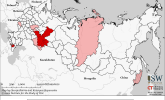July 13, 2022 - ISW Press
The Kremlin likely ordered Russian “federal subjects” (regions) to form volunteer battalions to participate in the Russian invasion of Ukraine, instead of declaring partial or full mobilization in Russia. Russian war correspondent and milblogger Maksim Fomin stated that Russia has begun a “volunteer mobilization,” where every region must generate at least one volunteer battalion. The term “volunteer mobilization” likely implies that the Kremlin ordered the 85 “federal subjects” (regions, including occupied Sevastopol and Crimea) to recruit and financially incentivize volunteers to form new battalions, rather than referring to literal mobilization relying on conscription or the compulsory activation of all reservists in Russia. Russian outlets reported that regional officials recruit men up to 50 years old (or 60 for separate military specialties) for six-month contracts and offer salaries averaging 220,000 to 350,000 rubles per month (approximately $3,750 to $6,000). Separate regions offer an immediate enlistment bonus that averages 200,000 rubles (approximately $3,400) issued from the region‘s budget and social benefits for the servicemen and their families. Russian media has already confirmed the creation or deployment of volunteer battalions in Kursk, Primorskyi Krai, Republic of Bashkortostan, Chuvashia Republic, Chechnya, Republic of Tatarstan, Moscow City, Perm, Nizhny Novgorod, and Orenburg Oblasts in late June and early July. Tyumen Oblast officials announced the formation of volunteer units (not specifically a battalion) on July 7.










